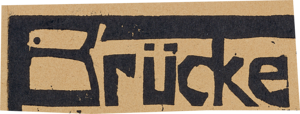The situation of the Brücke Artists in the Nazi Period
Aya Soika
Professor for Art History / Bard College Berlin
At the beginning of the Nazi regime, the Brücke painters undoubtedly had opportunities for recognition within the new regime. Among their supporters were numerous people appointed to prominent positions owing to their Nationalist Conservative leanings, people who even during the interwar years had proposed that Expressionist art was a genuinely German alternative to the French-inspired Impressionism, drawing comparisons with the German Gothic and Romanticism. Emil Nolde, Erich Heckel and Karl Schmidt-Rottluff in particular were at the centre of a heated debate in the summer of 1933, which concerned the role of a “Nordic Expressionism” in the new nation. The Brücke painters residing within Germany were all incorporated into the newly founded Reich Chamber of Fine Arts. Indeed, some of them were even invited to the inauguration of the Reich Chamber of Culture, the umbrella organization newly established by Minister of Propaganda Joseph Goebbels, which took place on November 15, 1933 – all of which initially appeared to be a positive sign. The rather uncertain situation perhaps makes it easier to understand why Heckel and Nolde declared themselves willing to sign the “Aufruf der Kulturschaffenden”, or “call to the artists”, formulated by one of Goebbels’ colleagues, which confirmed Adolf Hitler as the head of state and was published on August 18, 1934, in the daily “Völkischer Beobachter”. In the course of the following years, it nevertheless became clear that, at most, their artistic positions were merely being tolerated and that the newly created structures primarily limited artists’ scope for activity and professional freedom. As long as there was a firm supporter base, who often knew the artists personally, their financial survival was guaranteed despite limited or even non-existent opportunities for exhibition – as well as, in some cases such as Nolde’s, even a ban on them practicing their profession. If, however, the collectors were forced to emigrate, as was the case for Max Pechstein in particular, then this impacted on the artists’ incomes too, which varied a great deal among the individuals.
While there were exhibitions in galleries, art associations and in certain cases also in museums, these included mainly landscapes from recent years, and presentation of current works came to a halt with the opening of the “Degenerate Art” exhibition in Munich in July 1937. The latter evidently took the artists by surprise. Even before that, there had been defamatory shows on a local level, but now such events were supported by the Nazi regime’s government and the artworks were derided with critical commentary on the display walls, by exhibition guides, and in the press coverage accompanying the shows. Public collections subsequently saw more of the artists’ works being removed and then being sold via a department of the Ministry of Propaganda and the dealers it commissioned. In some cases, artworks were even destroyed.
While Max Pechstein was able to organize a solo exhibition in Berlin in May 1939 – the first of the “degenerate” artists to do so, as he himself proudly noted – Karl Schmidt-Rottluff and Emil Nolde were thrown out of the Reich Chamber of Fine Arts in August 1941, which subsequently prevented them from exhibiting or selling any of their works. In retrospect, the decision on who was permitted to remain and who was not throws up a series of questions. Pechstein retained his membership even though the Nazi Gau administration issued a damning report as part of a suitability review. Nolde, on the other hand, was excluded (unofficially due to his high income, but officially due to his artistic unreliability), even though the local Nazi party section firmly vouched for him.
Disciplinary measures and reprisals by the state were just one factor in the overall picture, however, albeit a very decisive one in hampering the Brücke artists’ activities during the Nazi period and threatening their very livelihoods. The start of Allied bombing raids in 1942 represented a radical change in their contemporary circumstances compared to the first few years of the Nazi regime. Even before this, concern about the possible destruction of their artistic works had led to the painters giving certain pieces to acquaintances for safekeeping. From 1943 onwards the extensive bombing of Berlin also led to the destruction of the homes and studios of Heckel, Nolde, Pechstein and Schmidt-Rottluff, forcing them to relocate to the countryside. During the closing years of the war, for an artist like Pechstein who had been permitted to remain in the Reich Chamber of Fine Arts, the advantages of his membership were therefore barely noticeable. In theory, he had the right to exhibit, but there were no longer any large-scale exhibitions of his work during the course of the Second World War. In theory, he was also permitted to apply for rationed art materials, but his correspondence with the Reich Chamber of Fine Arts shows that many of the materials requested from 1943 could no longer be delivered – despite him having vouchers permitting him to obtain them. How the artists secured their livelihoods during these last years of the war varied a great deal from person to person, since the scope for action here was dependent less on official measures and more on personal connections.
Aya Soika is Professor of Art History at Bard College Berlin. She was most recently co-curator of the exhibition Escape into Art? The Brücke Artists in the Nazi Period (with Meike Hoffmann and Lisa Marei Schmidt, Brücke Museum and Kunsthaus Dahlem, Berlin, 2019) as well as the exhibition Emil Nolde – a German Legend. The Artist During the Nazi Regime with Bernhard Fulda and Christian Ring, (Nationalgalerie Staatliche Museen zu Berlin, 2019).
This excerpt is based on the text “Handlungsspielräume: Zwischen Anerkennung und Verfemung”, in: exhib. cat. Escape into Art? The Brücke Artists in the Nazi Period, edited by Meike Hoffmann, Lisa Marei Schmidt and Aya Soika, Brücke Museum, Berlin, (Hirmer Verlag: Munich, 2019), pp. 19–37.





